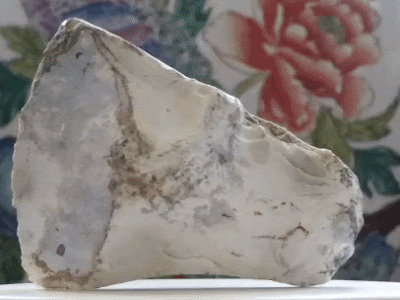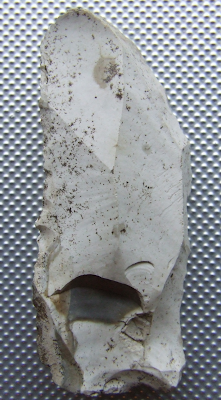
Sure, this is just a rock, you don't think that this could possibly be an axe head?

it has retouch on the cutting blade, controversial i know but can you see the rough shape and colour match to an Orca on the gray/white top surface shown in the second picture?
I don't see it... but please explain this. The colourations you're seeing there on the broken surface are the result of patination which takes at minimum hundreds of years and usually thousands of years to develop. Fresh flint is not white. It develops that colour as a result of hydration and chemical alteration which begins on the exterior and gradually progresses through to the interior. How could anyone know that the interior colouration pattern would resemble an orca before a flint nodule was broken open... or predict that it would ultimately develop in that way after it had been broken open?
I await your explanation with interest.
Ah... so it's a Hadrosaurus, not an orca. Sorry. My mistake. They're easily confused. Just a thought though... might it actually be the little-known Orcasaurus.
The 'fossil tooth' appears to be the lithified infill from a shrimp burrow. They're common in Britain in flint-bearing marine sedimentary deposits.
The video is hilarious.

This flint blade also from my find site has a differing patina on the lower edge, that platform was likely used for harfting, and the glue blocked oxidization in that area for an unknown length of time, glue has since gone, differance in patina remains.
The item you’re showing has a darker and more reflective patch because it has suffered a chip to that area which is very much more recent than the other fractures and an as-yet unpatinated portion has been exposed. No-one could have known what the underlying colour or pattern would be until after that chip had happened, and the same is true for your supposed ‘orca’ colouration.
There is no evidence of a chip, its one flat plain with two colours. Hmm not oxidization huh? wait a minute water is one part oxogen......
My pigments that I had tested with FTIR spectroscopy contain celulose, which is water proof....

The irony, you cant see the shape of a whale that is there, but you can see a chip that isnt. You need to brush up on a few things too, here is a paper covering oxidation on flint surfaces.
https://www.researchgate.net/public..._Loess_Terrain_of_the_Netherlands_and_Belgium
Oh I notice a lot of backtracking from you, case closed, go troll somewhere else.